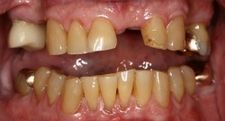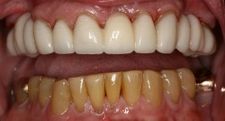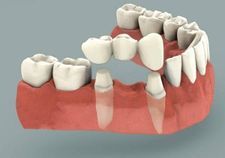The concept of a dental bridge is probably just what you would imagine. It literally bridges the gap of one or more missing teeth.
A dental bridge includes two crowns or caps for the anchoring teeth on either side of the gap, which are called abutment teeth – and a false tooth or teeth in between. The false teeth that fill the gap are called pontics and can be made from gold, alloys, porcelain, or a combination of these materials. We, at Kneib Dentistry, like to use the high-quality porcelain pontics. Dental bridges can be supported by natural teeth and/or implants.
 Before Full Upper Arch Resin Bridge
Before Full Upper Arch Resin Bridge

After Full Upper Arch Resin Bridge
A dental bridge can be one of the following:
- Traditional bridges (most common) involve creating a crown for the tooth or implant on either side of the missing tooth with a pontic (fake tooth) in between. Traditional bridges are made of either porcelain fused to metal (PFM) or all-porcelain.
- Cantilever bridges are used when there are adjacent teeth on only one side of the gap (missing tooth or teeth), in which it is not technically "bridging" the gap.
- Maryland bridges are made of plastic teeth and gums supported by a metal framework. Metal wings on each side of the bridge are bonded to your existing teeth.
- The restoration of your smile
- The restoration of your ability to properly chew and speak
- Maintaining the shape of your face
- Distributing the forces in your bite properly by replacing missing teeth
- Preventing remaining teeth from drifting out of position
 Traditional Bridge
Traditional Bridge
Dental Bridges FAQs
What type of dental bridge is best for me?
While traditional dental bridges are most common, they are not necessarily the right choice for every patient.
If you only have teeth adjacent to one side of your cap (the space missing one or multiple teeth), a Cantilever bridge may suit you best.
Maryland bridges are great for individuals who do not want to treat natural teeth beside the tooth cap. These types of bridges are used to replace a missing tooth or teeth without having to cap adjacent teeth. Instead, a metal framework connected to the porcelain tooth (that will fill the gap) is adhered with a bonding agent and metal wings to the teeth on either side of the cap.
To truly know which type of dental bridge is best for you, a consultation with your dentist is a must! Contact Kneib to schedule an appointment today.
Contact
Who is the best candidate for this type of restorative or cosmetic dental procedure?
Why should I consider getting a dental bridge?
Is there any risk associated with having a dental bridge installed?
How soon after having a dental bridge installed can I eat or drink?
Why are porcelain pontics a good choice for dental bridges?

